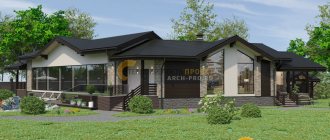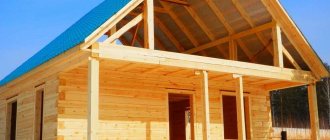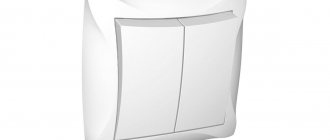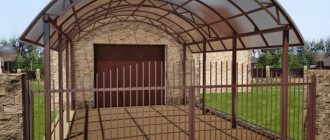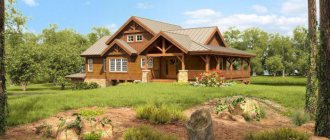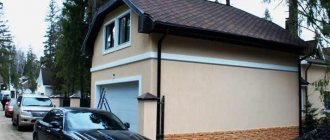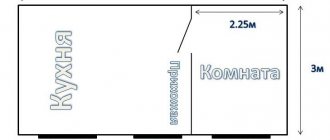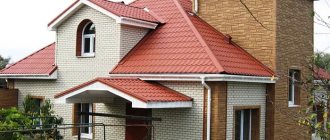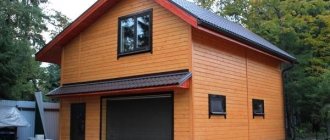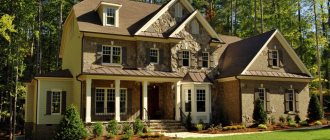With the advent of modern materials, it has become possible to build private houses in a wide variety of styles, and one of the most interesting options is the bungalow. The first association that arises with the word bungalow is Indians, tomahawks and the scalps of enemies, that is, British colonists. The bungalow was once their standard home and is still built like light one-story houses.
Bungalow style house project
In this building, many incompatible elements coexist quite successfully. There are features of European architecture, camping tents and, at the same time, luxurious oriental-style verandas.
A bungalow-style house is usually built on the shore of a pond or on a slope, since the use of a terrace implies a picturesque view.
Main features of a bungalow
A real bungalow-style house is made only from natural components such as wood, natural stone or bamboo.
The main color scheme has a red-brown tint. Additional decorative elements can be a stone hearth or fireplace, leather and bone products, and linen or cotton is used for woven decorations. Bright elements can be natural greenery or homemade items in folk style.
The structure of the home is also quite non-standard; in the center of the house there is a living room, around which the rest of the rooms are clustered.
Sample of interior design of bungalow style houses
According to the rules, a bungalow has only one floor, on which all the main rooms are located.
A bungalow-style house can be recognized from afar, as the structure has very recognizable outlines: a flat roof, a large porch and a spacious veranda.
Another feature of a bungalow-style house is its extremely low ceilings, but its width is very spacious, so during construction it is necessary to take this feature into account when planning a house on a large area.
Since the dwelling turns out to be quite squat, there is simply no need for stairs.
The rooms use a minimal amount of furniture, with all cabinets, shelves, etc. hidden in built-in niches. Only upholstered furniture, tables and chairs remain in sight. Moreover, all these products must be very elegant; monumental beds and sofas will not work.
One of the bungalow interior options
At the same time, the entire area of the premises must be used as efficiently as possible; unattended free spaces are unacceptable.
The entire interior is decorated using decorative elements in a rural style. The use of homespun fabrics, bright hand-made trinkets and ethnic motifs is encouraged. Other accessories will simply look out of place in such a setting.
general information
A bungalow is a one- or maximum two-story building designed to accommodate one family. A distinctive feature of such a dwelling is the presence of a central room, around which service premises and other rooms are located.
As before, now the main material for building a bungalow is wood. This is what creates the impression of coziness.
Wealthy people have bungalows either on the lake or on the coast. There are definitely picturesque forests nearby.
Such buildings are considered an ideal option for country living. Typically, bungalows are chosen by families or older people.
Building foundation
As a rule, a shallow monolithic or block concrete foundation is chosen as the foundation.
example of a foundation for a bungalow
A monolithic slab is used if the construction site has a relatively flat surface.
According to the project diagram, the surface of the earth is marked and the top layer of soil is removed, after which the bottom of the depression is carefully leveled.
- The sand cushion is filled in, and the drainage system is also laid at the same time.
- If the soil is soft enough, it is necessary to perform low formwork; if the soil is dense, this is not necessary.
- The recess is filled with cement mortar. In the case of a small slope, it makes sense to lay concrete in layers with gradual leveling of the main area.
- To save on cement mortar, you can lay flat stones as the first layer, and add small crushed stone to the mixture itself.
- Before pouring, reinforcement with a metal rod with a diameter of at least 12 mm must be performed. The thickness of the slab should be approximately 10-15 cm and the reinforcement should be placed exactly in the middle of the fill.
Example of correct foundation reinforcement - After leveling the last layer, we place vertical sections of reinforcement into the concrete pad; subsequently, they will connect the foundation and supports for the bungalow frame.
- We leave the monolithic slab to dry for several days.
A cement screed is applied over the concrete, this is necessary for laying hydro- and thermal insulation. As an insulating material, you can use two layers of roofing felt impregnated with hot bitumen.
If the area has noticeable differences, then concrete blocks are used, followed by filling them with cement mortar.
House frame
Initially, a frame is assembled from profile metal pipes or wooden beams. In the first case, welding or bolting is used with mandatory reinforcement with corners. In the second, special brackets are used as fastening elements.
Ready-made bungalow project with detailed layout
First of all, support columns are installed, which will bear the main load from the roof and walls of the house. Most often, six pieces are enough, because the house has only one floor and the lightest materials are selected for its manufacture.
The supports are attached to the reinforcing rods previously laid in the foundation, after which a metal corner is laid along the perimeter of the walls, both at the base and on top of the columns. A frame for the ceiling is made from the same corner.
Wall cladding
Before plating, all metal elements are first treated with an anti-corrosion agent. If the supports were made of wooden beams, it is impregnated with an antifungal antiseptic.
Since the walls of a bungalow, by definition, are not load-bearing, almost any material can be used to cover them, the main thing is that either it itself has good insulation or provides the opportunity to additionally lay it.
example of bungalow wall decoration
Usually these are tiled materials with good porosity on the outside of the house, which have good thermal insulation; plywood, plasterboard or hardboard can be used inside. Between them you can install additional hydro- and noise insulation. For the ceiling, asbestos-cement slabs or the same plasterboard are most often used.
Before starting the sheathing, it is necessary to mount a frame for the sheathing, which can also be made of a metal profile or wooden blocks; in order to save money without reducing the quality of construction, you can combine these two types of elements.
The only condition is that when choosing a material, it is necessary to comply with the cross-sectional dimensions. Both the ceiling and walls are made according to the same principle, the only difference is that in the first case, during installation it is necessary to maintain horizontality, in the second - vertical surfaces.
When covering the walls, do not forget about the window and door openings into which double frames are installed. It is preferable to install them immediately, then in case of gaps, all defects can be quickly eliminated.
Beginning of work
If you want to save money, you can build a 3x4 garden house. In order for you to succeed, you need to prepare high-quality materials and all the necessary tools in advance. All this needs to be chosen, depending on what kind of house you decide to build - panel or timber . Garden houses made of timber will last longer, but their construction will require the creation of a very powerful foundation, which must lie quite deep.
Panel buildings on a summer cottage are a choice for people who want to get inexpensive housing in a short time. Sheets of plywood are usually used to cover it. In just four days, a good-quality house for living in comfortable conditions will appear on your site.
How to make a roof
The roof can be made in different versions, the main condition is that it be flat with a slight slope. As a rule, a metal frame is also made from profile pipes, onto which the roofing material is attached. It can be slate, sheet iron or metallized plastic. The last option is even preferable, since it has the least weight.
When making a frame, you shouldn’t use too many elements, this will only make the structure heavier, but you shouldn’t give up stiffening ribs either. To provide thermal insulation, an insulating layer is laid directly on top of the ceiling; additional insulation is a layer of air. Whether to install gutters or not is at your discretion; in principle, there is no great need for them.
One of the options for finishing the roof of a bungalow
Architecture
The distinctive features of the bungalow include the horizontal orientation of the structure. There are no vertically oriented houses of this type, but in Vancouver (British Columbia), Sacramento, and Seattle, horizontal houses are built on a high-level foundation.
The main aspiration in the house designs was to place a large number of rooms on only one floor. This greatly simplified construction work, and it was much easier to install all the necessary equipment on the first floor rather than on the second floor. Pay attention to the photo where the bungalow houses are shown as large one-story buildings, with relatively low ceilings and light-colored facade decoration.
Bungalow house designs exclude the presence of stairs, which is very convenient not only for the elderly, but also for all household members.
It is much faster to leave a one-story building during a fire, and for this you can use not only door openings, but also window openings.
Veranda of a bungalow style house
The terrace of a bungalow is one of the characteristic features of such a house, so its design should also be given attention. Since a deck is also made above the veranda, supports are required for it. As a rule, wooden poles are used in this capacity, which fit perfectly into the overall interior.
The floor is mainly made of solid wood or laminate. When using the latter, you must remember that the veranda has direct access to the street, so it is necessary to use a moisture-resistant option.
If the terrace faces a steep slope, a parapet must be installed around the perimeter, this will ensure the safety of household members and guests.
Bungalow project with a large veranda
The design of the terrace involves the use of the same light furniture, for example, wicker, and a minimum of additional elements. The best decoration can be a wide variety of greenery.
A little history
The term “bungalow” originally appeared in India, in that part of the country called Bengal, which is now mostly part of Bangladesh. Small dwellings in this area were commonly called Bengali. The British brought designs for such houses to Europe in the early 1700s. The English workers who worked for the East India Company liked the bungalow, and later became popular in the United Kingdom.
More than 100 years later, bungalows began to actively appear in the United States, and at the beginning of the 20th century, such buildings became widespread in Australia.
We briefly touched on bungalows when we wrote about choosing the optimal design for a country house. Indeed, a typical bungalow is ideal as a summer house, as it fits perfectly into the natural landscape, while allowing you to enjoy comfort.
Initially, a bungalow was understood as a one-story house designed for one family, with a simple pitched roof and the mandatory presence of a spacious open veranda. However, over time, two-story, more elite bungalows began to appear, and experts began to identify several varieties of such houses.
Decoration of rooms in a bungalow
As already mentioned, the main material used in such a house is wood, and interior decoration is no exception. The floor is made of wooden boards or materials that resemble natural wood in structure. On top you can put a bamboo mat or an accessory borrowed from a hunting lodge, such as an animal skin.
Beams made in dark colors will look good on the ceiling.
One of the interior design options for a bungalow
To prevent the room from looking unkempt and gloomy, in contrast to the low dark ceilings, the walls are made in lighter shades, however, maintaining natural tones. The materials used to decorate the walls can be absolutely anything, but decorative plaster looks the most advantageous, the main thing is that the walls do not draw too much attention to themselves.
All finishing is done deliberately roughly to create the effect of hand-made work.
Since in the interior of a bungalow almost all surfaces have fairly dark tones, to dilute the general background, furniture is chosen mainly in light shades. These should be light, non-massive products with fairly strict shapes, and low-slung sofas and armchairs. One of the best options is wicker furniture.
Decoration Materials
Any modern materials are suitable for finishing, the main thing is to maintain the general style and color background of the interior. Decorative plaster, fabric, paint and wallpaper are suitable for the ceiling and walls. The floor can be wooden or carpeted; linoleum and tiles are acceptable. The windows are most often ordinary metal-plastic with curtains made of natural fabrics.
Handmade crafts, flower pots and bamboo rugs will also fit seamlessly into the interior.
The name “bungalow” is associated with something exotic, with a house on the beach, under a reed roof, overlooking the ocean. Meanwhile, a bungalow is a cozy modern home; this construction option has become widespread in various countries. Let's understand the features of a bungalow.
